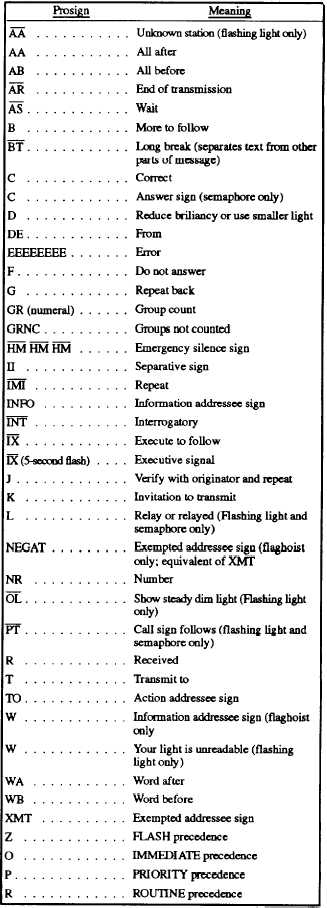ADDRESS OF MESSAGE
Most messages have at least one addressee
responsible for taking action on the contents and for
originating any necessary reply. Other addressees with
an official concern in the subject of the message but
who do not have the primary responsibility for acting
on it receive the message for information. Do not be
confused by the term information addressee. Even
though an information addressee usually is concerned
only indirectly with a message, frequently action of
some nature must be taken within the command. Some
messages have only information addressees. Exempt
addressees are used when the originator desires to
exclude one or more authorities from a collective title.
PROSIGNS
LEARNING OBJECTIVES: Define prosign.
Match prosigns with their meanings.
Procedure signs, or prosigns, consist of one or
more letters or characters or combination thereof, used
to aid communication by conveying, in a condensed
form, certain frequently used orders, instructions,
requests, and information relating to communication.
Figure 3-1 is a list of prosigns, and their meanings, that
are authorized for use in visual signaling. No others
may be used. An overscore (a line over two or more
letters) indicates that the letters overscored are to be
transmitted as a single character (no pause between
letters). ACP 129, Communications Instruction,
visual Signaling Procedures, contains the procedures
for the use of prosigns.
NAVAL MESSAGE FORMAT
LEARNING OBJECTIVE: Identify the parts,
components, and elements of the basic naval
message format.
Figure 3-2 shows a message copied as received
by flashing light. Figure 3-3 represents the standard
format of naval messages. Study the figure and
compare it with the message.
Each message prepared in either plaindress,
abbreviated codress, or codress will have three parts:
heading, text, and ending. Each message part has
certain components, which are broken down into
elements and contents. Format lines 2, 3, 4, 14, 15, and
16 (fig. 3-3) identify the procedural portions of the
3-2
Figure 3-1.—Authorized prosigns and their meanings.



